Zircon LA-ICP-MS Dating and Geochemical Characteristics of Rhyolites from the Qushi Area, Tengchong Terrane, Yunnan Province
Abstract
1. Introduction
2. Geological Setting
3. Samples and Analytical Methods
3.1. Geochemical Analysis
3.2. Zircon U-Pb Dating and Trace Element Analysis
4. Results
4.1. Petrography Characteristics
4.2. Geochemical Features
4.3. Zircon U-Pb Geochronology
5. Discussion
5.1. Cretaceous Magmatism in Tengchong Terrane
5.2. Rhyolite and Its Petrogenesis
5.3. Tectonic Significance
- (1)
- Zircon LA-ICP-MS U-Pb dating indicates that the Qushi rhyolites were crystallized from 118.3 Ma to 120.5 Ma, representing Early Cretaceous magmatic activity in the Tengchong terrane. Additionally, the rhyolites contain inherited zircon ages of approximately 198.5 Ma, suggesting the potential presence of Early Jurassic igneous units in the basement of the Qushi region.
- (2)
- The Qushi rhyolites are classified as acidic, calc-alkaline rhyolites with weakly peraluminous-to-peraluminous characteristics and exhibit petrogeochemical characteristics of enrichment in LREE, Rb, K, Th, U, Ce, La, Zr and Hf and depletion of HREE, Nb, Ta, P, Ti, Sr and Ba.
- (3)
- The A/CNK values of the Qushi rhyolites range from 1.07 to 2.86, alongside Sr content variations from 12.4 to 244.7 ppm, suggest both I-type and S-type granite affinities, indicative of crustal melting with plagioclase fractionation.
- (4)
- The Qushi rhyolites probably formed in syn-COLG and VAG tectonic settings related to the combined effects of the subduction and the closure of the MTO.
Supplementary Materials
Author Contributions
Funding
Data Availability Statement
Acknowledgments
Conflicts of Interest
References
- Metcalfe, I. Gondwana dispersion and Asian accretion: Tectonic and palaeogeographic evolution of eastern Tethys. J. Asian Earth Sci. 2013, 66, 1–33. [Google Scholar] [CrossRef]
- Zhu, D.C.; Mo, X.; Niu, Y.; Zhao, Z.; Wang, L.; Liu, Y.; Wu, F. Geochemical investigation of Early Cretaceous igneous rocks along an east–west traverse throughout the central Lhasa Terrane, Tibet. Chem. Geol. 2009, 268, 298–312. [Google Scholar] [CrossRef]
- Hou, Z.; Zhang, H. Geodynamics and metallogeny of the eastern Tethyan metallogenic domain. Ore Geol. Rev. 2015, 70, 346–384. [Google Scholar] [CrossRef]
- Hu, X.; Garzanti, E.; Wang, J.; Huang, W.; An, W.; Webb, A.A. The timing of India-Asia collision onset–Facts, theories, controversies. Earth-Sci. Rev. 2016, 160, 264–299. [Google Scholar] [CrossRef]
- Cao, H.-W.; Zhang, Y.-H.; Santosh, M.; Zhang, S.-T.; Tang, L.; Pei, Q.-M. Mineralogy, zircon U–Pb–Hf isotopes, and whole-rock geochemistry of Late Cretaceous–Eocene granites from the Tengchong terrane, western Yunnan, China: Record of the closure of the Neo-Tethyan Ocean. Geol. J. 2017, 52, 1423–1441. [Google Scholar] [CrossRef]
- Cao, H.; Zhang, Y.; Tang, L.; Hollis, S.P.; Zhang, S.; Pei, Q.; Yang, C.; Zhu, X. Geochemistry, zircon U–Pb geochronology and Hf isotopes of Jurassic-Cretaceous granites in the Tengchong terrane, SW China: Implications for the Mesozoic tectono-magmatic evolution of the Eastern Tethyan Tectonic Domain. Int. Geol. Rev. 2019, 61, 257–279. [Google Scholar] [CrossRef]
- Kong, X.; Mi, W.; Zhu, L.; Yang, W. Zircon U-Pb chronology and provenance of the Paleogene sandstones in the Nima basin, Tibet: Implication for coeval paleogeography. Arab. J. Geosci. 2019, 12, 692. [Google Scholar] [CrossRef]
- Zhu, D.C.; Wang, Q.; Zhao, Z.D.; Chung, S.L.; Cawood, P.A.; Niu, Y.; Mo, X.X. Magmatic record of India-Asia collision. Sci. Rep. 2015, 5, 14289. [Google Scholar] [CrossRef] [PubMed]
- Qi, X.X.; Sheng, H.; Wei, C.; Ren, Y.F.; Cai, Z.H.; Ji, F.B.; Liang, F.; Liu, X. Longlin-Ruili subduction-accretionary complex belt in the southeastern Gaoligong orogen, and its relationship with the evolution of the Meso-Tethyan Ocean. Acta Petrol. Sin. 2021, 37, 3067–3094, (In Chinese with English abstract). [Google Scholar]
- Yin, A.; Harrison, T. Geologic Evolution of the Himalayan-Tibetan Orogen. Annu. Rev. Earth Planet. Sci. 2000, 28, 211–280. [Google Scholar] [CrossRef]
- Zhu, R.Z.; Lai, S.; Paterson, S.R.; Luffi, P.; Zhang, B.; Pompe, L.R. Westward migration of high-magma addition rate events in SE Tibet. Tectonophysics 2022, 807, 229096. [Google Scholar] [CrossRef]
- Kornfeld, D.; Eckert, S.; Appel, E.; Ratschbacher, L.; Sonntag, B.; Pfänder, J.A.; Ding, L.; Liu, D. Cenozoic clockwise rotation of the Tengchong block, southeastern Tibetan Plateau: A paleomagnetic and geochronologic study. Tectonophysics 2014, 628, 105–122. [Google Scholar] [CrossRef]
- Xu, Z.Q.; Wang, Q.; Cai, Z.H.; Dong, H.W.; Li, H.Q.; Chen, X.J.; Duan, X.D.; Cao, H.; Li, J.; Burg, J.-P. Kinematics of the Tengchong terrane in SE Tibet from the Late Eocene to Early Miocene: Insights from coeval mid-crustal detachments and strike-slip shear zones. Tectonophysics 2015, 665, 127–148. [Google Scholar] [CrossRef]
- Qu, X.X.; Wang, R.; Xin, H.; Jiang, J.; Chen, H. Age and petrogenesis of A-type granites in the middle segment of the Bangonghu–Nujiang suture, Tibetan plateau. Lithos 2012, 146–147, 264–275. [Google Scholar] [CrossRef]
- Chen, Y.; Zhu, D.; Zhao, Z.; Meng, F.; Wang, Q.; Santosh, M.; Wang, L.; Dong, G.; Mo, X. Slab breakoff triggered ca. 113 Ma magmatism around Xainza area of the Lhasa Terrane, Tibet. Gondwana Res. 2014, 26, 449–463. [Google Scholar]
- Li, F.; Tang, J.; Wang, N.; Liu, Z.; Song, Y.; Zhang, J.; Ma, X.; Fu, B.; Li, H.; Han, S. Petrogenesis and Geodynamic Implications of Early Cretaceous (∼130 Ma) Magmatism in the Baingoin Batholith, Central Tibet: Products of Subducting Slab Rollback. Acta Geol. Sin. (Engl. Ed.) 2022, 96, 1960–1978. [Google Scholar] [CrossRef]
- Zhu, D.C.; Zhao, Z.; Niu, Y.; Mo, X.; Chung, S.; Hou, Z.; Wang, L.; Wu, F. The Lhasa Terrane: Record of a microcontinent and its histories of drift and growth. Earth Planet. Sci. Lett. 2011, 301, 241–255. [Google Scholar]
- Mi, W.T.; Kong, X.; Zhang, D.; Hu, J.; Wan, Y. Zircon LA-ICP-MS dating and geochemical characteristics of I-type granitoids from the Yanhu area, west segment of the Bangongco-Nujiang suture (western Tibet): Petrogenesis and implications for the southward subduction of the Tethyan Ocean. J. Geol. Soc. India 2017, 90, 335–346. [Google Scholar] [CrossRef]
- Ma, X.; Song, Y.; Tang, J.; Chen, W. Newly identified rhyolite-biotite monzogranite (A2-type granite)-norite belt from the Bangong-Nujiang collision zone in Tibet Plateau: Evidence for the slab break-off beneath the Lhasa Terrane. Lithos 2020, 366–367, 105565. [Google Scholar] [CrossRef]
- Li, Y.; He, J.; Wang, C.; Santosh, M.; Dai, J.; Zhang, Y.; Wei, Y.; Wang, J. Late Cretaceous K-rich magmatism in central Tibet: Evidence for early elevation of the Tibetan plateau? Lithos 2013, 160, 1–13. [Google Scholar] [CrossRef]
- Wang, Q.; Zhu, D.; Zhao, Z.; Liu, S.; Chung, S.; Li, S.; Liu, D.; Dai, J.; Wang, L.; Mo, X. Origin of the ca. 90 Ma magnesia-rich volcanic rocks in SE Nyima, central Tibet: Products of lithospheric delamination beneath the Lhasa-Qiangtang collision zone. Lithos 2014, 198, 24–37. [Google Scholar] [CrossRef]
- Chen, J.; Xu, J.; Yu, H.; Wang, B.; Wu, J.; Feng, Y. Late Cretaceous high-Mg# granitoids in southern Tibet: Implications for the early crustal thickening and tectonic evolution of the Tibetan Plateau? Lithos 2015, 232, 12–22. [Google Scholar]
- Yi, J.; Wang, Q.; Zhu, D.; Li, S.; Liu, S.; Wang, R.; Zhang, L.L.; Zhao, Z. Westward-younging high-Mg adakitic magmatism in central Tibet: Record of a westward-migrating lithospheric foundering beneath the Lhasa–Qiangtang collision zone during the Late Cretaceous. Lithos 2018, 316, 92–103. [Google Scholar] [CrossRef]
- Sun, M.; Tang, J.; Chen, W.; Ma, X.; Qu, X.; Song, Y.; Li, X.; Ding, J. Process of lithospheric delamination beneath the Lhasa–Qiangtang collision orogen: Constraints from the geochronology and geochemistry of Late Cretaceous volcanic rocks in the Lhasa terrane, central Tibet. Lithos 2020, 356, 10529. [Google Scholar] [CrossRef]
- Yang, X.; Zhang, Z.; Zhou, Y.; Yang, J. Spatio-temporal analysis of Permian-Cretaceous magmatic activities in the Tengchong block: Implications for its tectono-magmatic evolution. Geosci. Front. 2024, 15, 101920. [Google Scholar] [CrossRef]
- Wang, G.; Liu, Z.; Tan, S.; He, X.; Wang, Y.; Qi, C.; Ye, H. Petrogenesis of the Early Jurassic Longtang and Menglong Peraluminous Granites in Tengchong Terrane, and their Tectonic Implication. Acta Geol. Sin. (Engl. Ed.) 2022, 96, 1079–1990. [Google Scholar] [CrossRef]
- Zhu, R.Z.; Lai, S.; Qin, J.; Zhao, S. Early-Cretaceous highly fractionated I-type granites from the northern Tengchong block, western Yunnan, SW China: Petrogenesis and tectonic implications. J. Asian Earth Sci. 2015, 100, 145–163. [Google Scholar] [CrossRef]
- Zhu, R.Z.; Lai, S.; Qin, J.; Zhao, S. Petrogenesis of late Paleozoic-to-early Mesozoic granitoids and metagabbroic rocks of the Tengchong Block, SW China: Implications for the evolution of the eastern Paleo-Tethys. Int. J. Earth Sci. 2017, 107, 431–457. [Google Scholar] [CrossRef]
- Zhao, S.; Lai, S.; Qin, J.; Zhu, R. Tectono-magmatic evolution of the Gaoligong belt, southeastern margin of the Tibetan plateau: Constraints from granitic gneisses and granitoid intrusions. Gondwana Res. 2016, 35, 238–256. [Google Scholar] [CrossRef]
- Xu, Y.G.; Yang, Q.J.; Lan, J.B.; Luo, Z.Y.; Huang, X.L.; Shi, Y.R.; Xie, L.W. Temporal-spatial distribution and tectonic implications of the batholiths in the Gaoligong-Tengliang-Yingjiang area, western Yunnan: Constraints from zircon U-Pb ages and Hf isotopes. J. Asian Earth Sci. 2012, 53, 151–175. [Google Scholar] [CrossRef]
- Qi, X.; Zhu, L.; Grimmer, J.C.; Hu, Z. Tracing the Transhimalayan magmatic belt and the Lhasa block southward using zircon U–Pb, Lu–Hf isotopic and geochemical data: Cretaceous—Cenozoic granitoids in the Tengchong block, Yunnan, China. J. Asian Earth Sci. 2015, 110, 170–188. [Google Scholar] [CrossRef]
- Chen, X.; Hu, R.; Bi, X.; Zhong, H.; Lan, J.; Zhao, C.; Zhu, J. Petrogenesis of metaluminous A-type granitoids in the Tengchong–Lianghe tin belt of southwestern China: Evidences from zircon U–Pb ages and Hf–O isotopes, and whole-rock Sr–Nd isotopes. Lithos 2015, 212, 93–110. [Google Scholar] [CrossRef]
- Zhao, S.; Lai, S.; Qin, J.; Zhu, R.; Wang, J. Geochemical and geochronological characteristics of Late Cretaceous to Early Paleocene granitoids in the Tengchong Block, Southwestern China: Implications for crustal anatexis and thickness variations along the eastern Neo-Tethys subduction zone. Tectonophysics 2017, 694, 87–100. [Google Scholar] [CrossRef]
- Cao, H.; Zou, H.; Zhang, Y.H.; Zhang, S.T.; Zheng, L.; Zhang, L.K.; Tang, L.; Pei, Q.-M. Late Cretaceous magmatism and related metallogeny in the Tengchong area: Evidence from geochronological, isotopic and geochemical data from the Xiaolonghe Sn deposit, western Yunnan, China. Ore Geol. Rev. 2016, 78, 196–212. [Google Scholar] [CrossRef]
- Bouilhol, P.; Jagoutz, O.; Hanchar, J.M.; Dudas, F.O. Dating the India–Eurasia collision through arc magmatic records. Earth Planet. Sci. Lett. 2013, 366, 163–175. [Google Scholar] [CrossRef]
- Chung, S.; Chu, M.F.; Zhang, Y.; Xie, Y.; Lo, C.H.; Lee, T.Y.; Lan, C.Y.; Li, X.; Zhang, Q.R.; Wang, Y. Tibetan tectonic evolution inferred from spatial and temporal variations in post-collisional magmatism. Earth-Sci. Rev. 2005, 68, 173–196. [Google Scholar] [CrossRef]
- Chapman, J.B.; Scoggin, S.H.; Kapp, P.A.; Carrapa, B.; Ducea, M.; Worthington, J.R.; Oimahmadov, I.; Gadoev, M. Mesozoic to Cenozoic magmatic history of the Pamir. Earth Planet. Sci. Lett. 2018, 482, 181–192. [Google Scholar] [CrossRef]
- Zhao, S.; Fang, X.; Tai, W.; Lai, S.; Pei, X.; Li, Z. Origin of granitic magma within continental margin arc magmatic lull: Constraints by the Late Cretaceous granites in Tengchong Block, SE Tibet. Acta Petrol. Sin. 2025, 41, 91–111, (In Chinese with English abstract). [Google Scholar]
- Yunnan Institute of Geological Sciences (YIGS). Regional Geological Survey Report of the Qushijie, Dajujie, and Dadongjie Areas at 1:50,000 Scale, Yunnan Province; Yunnan Institute of Geological Sciences: Kunming, China, 2004. (In Chinese) [Google Scholar]
- Sun, S.S.; McDonough, W.F. Chemical and isotopic systematics of oceanic basalts: Implications for mantle composition and processes. Geol. Soc. Spec. Pub. 1989, 42, 313–345. [Google Scholar] [CrossRef]
- Zong, K.; Klemd, R.; Yuan, Y.; He, Z.Y.; Guo, J.L.; Shi, X.L.; Liu, Y.S.; Hu, Z.C.; Zhang, Z.M. The assembly of Rodinia: The correlation of early Neoproterozoic (ca. 900 Ma) high-grade metamorphism and continental arc formation in the southern Beishan Orogen, southern Central Asian Orogenic Belt (CAOB). Precambrian Res. 2017, 290, 32–48. [Google Scholar] [CrossRef]
- Hu, Z.C.; Zhang, W.; Liu, Y.S.; Gao, S.; Li, M.; Zong, K.Q.; Chen, H.H.; Hu, S.H. “Wave” signal-smoothing and mercury-removing device for laser ablation quadrupole and multiple collector ICPMS analysis: Application to lead isotope analysis. Anal. Chem. 2015, 87, 1152–1157. [Google Scholar] [CrossRef] [PubMed]
- Hu, Z.C.; Li, X.H.; Luo, T.; Zhang, W.; Crowley, J.; Li, Q.L.; Ling, X.X.; Yang, C.; Li, Y.; Feng, L.P.; et al. Tanz zircon megacrysts: A new zircon reference material for the microbeam determination of U–Pb ages and Zr–O isotopes. J. Anal. At. Spectrom. 2021, 36, 2715–2734. [Google Scholar] [CrossRef]
- Liu, Y.S.; Hu, Z.C.; Gao, S.; Günther, D.; Xu, J.; Gao, C.G.; Chen, H.H. In situ analysis of major and trace elements of anhydrous minerals by LA-ICP-MS without applying an internal standard. Chem. Geol. 2008, 257, 34–43. [Google Scholar] [CrossRef]
- Liu, Y.S.; Gao, S.; Hu, Z.C.; Gao, C.G.; Zong, K.Q.; Wang, D.B. Continental and oceanic crust recycling-induced melt-peridotite interactions in the Trans-North China Orogen: U-Pb dating, Hf isotopes and trace elements in zircons of mantle xenoliths. J. Petrol. 2010, 51, 537–571. [Google Scholar] [CrossRef]
- Ludwig, K.R. ISOPLOT 3.00: A Geochronological Toolkit for Microsoft Excel; Berkeley Geochronology Center: Berkeley, CA, USA, 2003; Volume 4, pp. 1–70. [Google Scholar]
- Ferry, J.M.; Watson, E.B. New thermodynamic models and revised calibrations for the Ti-in-zircon and Zr-in-rutile thermometers. Contr. Mineral. Petrol. 2007, 154, 429–437. [Google Scholar] [CrossRef]
- Hayashi, K.; Fujisawa, H.; Holland, H.D.; Ohmoto, H. Geochemistry of ∼1.9 Ga sedimentary rocks from northeastern Labrador, Canada. Geochim. Cosmochim. Acta 1997, 61, 4115–4137. [Google Scholar] [CrossRef]
- He, B.; Zhong, Y.; Xu, Y.; Li, X. Triggers of Permo-Triassic boundary mass extinction in South China: The Siberian Traps or Paleo-Tethys ignimbrite flare-up? Lithos 2014, 204, 258–267. [Google Scholar] [CrossRef]
- Winchester, J.A.; Floyd, P.A. Geochemical discrimination of different magma series and their differentiation products using immobile elements. Chem. Geol. 1977, 20, 325–343. [Google Scholar] [CrossRef]
- Cao, H.; Zhang, Y.H.; Pei, Q.M.; Zhang, R.Q.; Tang, L.; Lin, B.; Cai, G.J. U–Pb dating of zircon and cassiterite from the Early Cretaceous Jiaojiguan iron-tin polymetallic deposit, implications for magmatism and metallogeny of the Tengchong area, western Yunnan, China. Int. Geol. Rev. 2017, 59, 234. [Google Scholar] [CrossRef]
- Whalen, J.B.; Currie, K.L.; Chappell, B.W. A-type granites: Geochemical characteristics, discrimination and petrogenesis. Contr. Mineral. Petrol. 1987, 95, 407–419. [Google Scholar] [CrossRef]
- Zhu, R.Z.; Lai, S.C.; Qin, J.; Zhao, S. Early-Cretaceous Syenites and Granites in the Northeastern Tengchong Block, SW China: Petrogenesis and Tectonic Implications. Acta Geol. Sin. Engl. Ed. 2018, 92, 1349–1365. [Google Scholar] [CrossRef]
- Qi, X.; Shen, H.; Ren, Y.; Wei, C.; Cai, Z.; Zhang, C.; Ji, F.; Liang, F. Early Cretaceous volcanism in the northwestern Gaoligong orogen and its relationship with subduction of the Nujiang Ocean: Evidence from geochemistry, zircon U-Pb dating and Hf isotopic compositions of rhyolites. Acta Petrol. Sin. 2020, 36, 2946–2962, (In Chinese with English abstract). [Google Scholar]
- Yu, L. Genesis and Tectonic Significance of the Mesozoic Granitoids in the Tengchong-Baoshan Block, Sanjiang Area. Ph.D. Thesis, China University of Geosciences, Beijing, China, 2016; 137p. [Google Scholar]
- Ma, X.; Shu, L.; Meert, J.G.; Li, J. The paleozoic evolution of central tianshan: Geochemical and geochronological evidence. Gondwana Res. 2014, 25, 797–819. [Google Scholar] [CrossRef]
- Zhou, S.M. Petrogenesis of the Late Triassic-Early Eocene Granitoids in the Tengchong Block. Ph.D. Thesis, China University of Geosciences, Beijing, China, 2019; 168p. (In Chinese). [Google Scholar]
- Cao, H.; Zhang, S.T.; Lin, J.Z.; Zheng, L.; Wu, J.D.; Li, D. Geology, geochemistry and geochronology of the Jiaojiguanliangzi Fe-polymetallic deposit, Tengchong County, Western Yunnan (China): Regional tectonic implications. J. Asian Earth Sci. 2014, 81, 142–152. [Google Scholar] [CrossRef]
- Xie, J.C.; Zhu, D.C.; Dong, G.C.; Zhao, Z.D.; Wang, Q.; Mo, X.X. Linking the Tengchong Terrane in SW Yunnan with the Lhasa Terrane in southern Tibet through magmatic correlation. Gondwana Res. 2016, 39, 217–229. [Google Scholar] [CrossRef]
- Li, Z.H.; Lin, S.L.; Cong, F.; Xie, T.; Zou, G.F. U-Pb ages of zircon from metamorphic rocks of the Gaoligongshan Group in western Yunnan and its tectonic significance. Acta Petrol. Sin. 2012, 28, 1529–1541, (In Chinese with English abstract). [Google Scholar]
- Qi, X.X.; Zhu, L.H.; Hu, Z.C.; Li, Z.Q. Zircon SHRIMP U-Pb dating and Lu-Hf isotopic composition for Early Cretaceous plutonic rocks in Tengchong block, southeastern Tibet, and its tectonic implications. Acta Petrol. Sin. 2011, 27, 3409–3421, (In Chinese with English abstract). [Google Scholar]
- Cong, F.; Lin, S.; Zou, G.; Li, Z.; Xie, T.; Peng, Z.; Liang, T. Magma mixing of granites at Lianghe: In-situ zircon analysis for trace elements, U-Pb ages and Hf isotopes. Sci. China Earth Sci. 2011, 54, 1346–1359. [Google Scholar] [CrossRef]
- Fang, Y.; Zhang, Y.; Zhang, S.; Cao, H.; Zou, H.; Dong, J. Early Cretaceous I-type granites in the Tengchong terrane: New constraints on the late Mesozoic tectonic evolution of southwestern China. Geosci. Front. 2018, 9, 459–470. [Google Scholar] [CrossRef]
- Chappell, B.W.; White, A.J. Two contrasting granite types. J. Geol. Soc. Aust. 1974, 21, 353–369. [Google Scholar]
- Zhu, R.Z.; Lai, S.; Santosh, M.; Qin, J.; Zhao, S. Early Cretaceous Na-rich granitoids and their enclaves in the Tengchong Block, SW China: Magmatism in relation to subduction of the Bangong-Nujiang Tethys ocean. Lithos 2017, 286, 175–190. [Google Scholar] [CrossRef]
- Zhang, J.; Peng, T.; Fan, W.; Zhao, G.; Dong, X.; Gao, J.; Peng, B.; Wei, C.; Xia, X.; Chen, L.; et al. Petrogenesis of the Early Cretaceous granitoids and its mafic enclaves in the Northern Tengchong Terrane, southern margin of the Tibetan Plateau and its tectonic implications. Lithos 2018, 314–315, 283–298. [Google Scholar] [CrossRef]
- Qi, X.; Wei, C.; Zhang, C.; Zhang, S.; Hu, Z.; Ji, F. Southward extension of the Bangonghu–Nujiang Suture: Evidence from Early Cretaceous intermediate and felsic magmatism in the Gaoligong Orogen, China. J. Asian Earth Sci. 2019, 182, 1–25. [Google Scholar] [CrossRef]
- Chen, Y.; Li, G.; Qin, L.; Lu, Y.; Jiang, C. Geochronology and geochemistry of Cretaceous–Eocene granites, Tengchong Block (SW China): Petrogenesis and implications for Mesozoic-Cenozoic tectonic evolution of Eastern Tethys. Geosci. Front. 2022, 13, 101338. [Google Scholar] [CrossRef]
- Zhang, J.; Fan, W.; Xu, X.; Peng, T.; Ratschbacher, L.; Wang, B. Early Cretaceous magmatism in Yunnan traces the tectonic transition from the Tengchong-Baoshan continental collision to Neo-Tethyan slab rollback. Lithos 2023, 456, 106717. [Google Scholar] [CrossRef]
- Altherr, R.; Holl, A.; Hegner, E.; Langer, C.; Kreuzer, H. High-potassium, calc-alkaline I-type plutonism in the European Variscides: Northern Vosges (France) and northern Schwarzwald (Germany). Lithos 2000, 50, 51–73. [Google Scholar] [CrossRef]
- Sylvester, P.J. Post-collisional strongly peraluminous granites. Lithos 1998, 45, 29–44. [Google Scholar] [CrossRef]
- Pearce, J.A.; Harris, N.B.W.; Tindle, A.G. Trace element discrimination diagrams for the tectonic interpretation of granitic rocks. J. Petrol. 1984, 25, 956–983. [Google Scholar] [CrossRef]
- Yang, J.; Cawood, P.A.; Du, Y.; Huang, H.; Hu, L. Detrital record of Indosinian mountain building in SW China: Provenance of the Middle Triassic turbidites in the Youjiang Basin. Tectonophysics 2012, 574, 105–117. [Google Scholar] [CrossRef]
- Yang, J.; Cawood, P.A.; Du, Y.; Huang, H.; Huang, H.; Tao, P. Large Igneous Province and magmatic arc sourced Permian–Triassic volcanogenic sediments in China. Sediment. Geol. 2012, 261, 120–131. [Google Scholar] [CrossRef]
- He, X.; Liu, Z.; Wang, G.; Leonard, N.D.; Tao, W.; Tan, S. Petrogenesis and tectonic setting of the Early Cretaceous granitoids in the eastern Tengchong terrane, SW China: Constraint on the evolution of Meso-Tethys. Lithosphere 2020, 12, 150–165. [Google Scholar] [CrossRef]
- Chen, X.; Hu, R.; Bi, X.; Li, H.; Lan, J.; Zhao, C.; Zhu, J. Cassiterite LA-MC-ICP-MS U/Pb and muscovite 40Ar/39Ar dating of tin deposits in the Tengchong-Lianghe tin district, NW Yunnan, China. Miner. Depos. 2014, 49, 843–860. [Google Scholar] [CrossRef]
- Zhang, J.; Fan, W.; Peng, T.; Ratschbacher, L. Southeastern continuation of the Bangong-Nujiang suture zone: Constraints from Middle Jurassic–Early Cretaceous sedimentary rocks in the western Baoshan block, SW China. J. Asian Earth Sci. 2021, 212, 104944. [Google Scholar] [CrossRef]
- Zhang, J.; Fan, W.; Peng, T.; Ratschbacher, L. An early cretaceous arc–back-arc system in western Yunnan, SW China: Constraints from U-Pb zircon ages and geochemistry of volcanic rocks in the western Baoshan block. Lithos 2022, 412, 106555. [Google Scholar] [CrossRef]
- Cong, F.; Lin, S.; Zou, G.; Xie, T.; Li, Z.; Tang, F.; Peng, Z. Geochronology and Petrogenesis for the Protolith of Biotite Plagioclase Gneiss at Lianghe, Western Yunnan. Acta Geol. Sin. (Engl. Ed.) 2011, 85, 891–904. [Google Scholar] [CrossRef]
- Deng, J.; Wang, Q.; Li, G.; Li, C.; Wang, C. Tethys tectonic evolution and its bearing on the distribution of important mineral deposits in the Sanjiang region, SW China. Gondwana Res. 2014, 26, 419–437. [Google Scholar] [CrossRef]
- Li, J.; Zhang, L.; Fan, W.; Ding, L.; Sun, Y.; Peng, T.; Li, G.; Sein, K. Mesozoic-Cenozoic tectonic evolution and metallogeny in Myanmar: Evidence from zircon/cassiterite U–Pb and molybdenite Re–Os geochronology. Ore Geol. Rev. 2018, 97, 829–845. [Google Scholar] [CrossRef]
- Mao, W.; Zhong, H.; Yang, J.; Liu, L.; Fu, Y.; Zhang, X.; Doh, S.H. Geochronology of Sn mineralization in Myanmar: Metallogenic implications. Econ. Geol. 2022, 117, 1387–1403. [Google Scholar] [CrossRef]
- Mao, W.; Zhong, H.; Yang, J.; Tang, Y.; Liu, L.; Fu, Y.; Zhang, X.; Sein, K.; Aung, S.M.; Li, J.; et al. Combined Zircon, Molybdenite, and Cassiterite Geochronology and Cassiterite Geochemistry of the Kuntabin Tin-Tungsten Deposit in Myanmar. Econ. Geol. 2020, 115, 603–625. [Google Scholar] [CrossRef]
- Liu, C.; Chung, S.; Wu, F.; Zhang, C.; Xu, Y.; Wang, J.; Chen, Y.; Guo, S. Tethyan suturing in Southeast Asia: Zircon U-Pb and Hf-O isotopic constraints from Myanmar ophiolites. Geology 2016, 44, 311–314. [Google Scholar] [CrossRef]
- Warr, L.N. IMA-CNMNC approved mineral symbols. Mineral. Mag. 2021, 85, 291–320. [Google Scholar] [CrossRef]
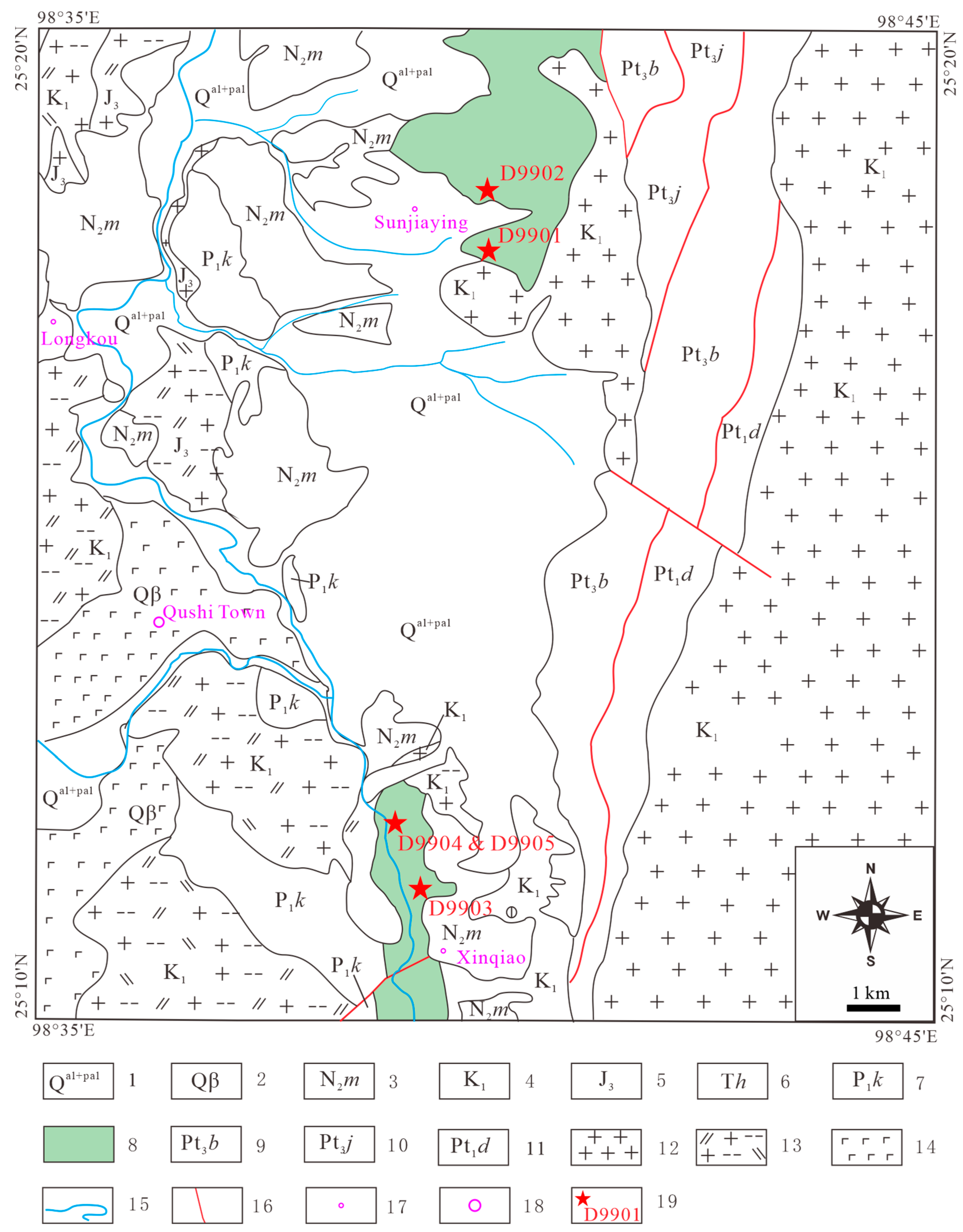
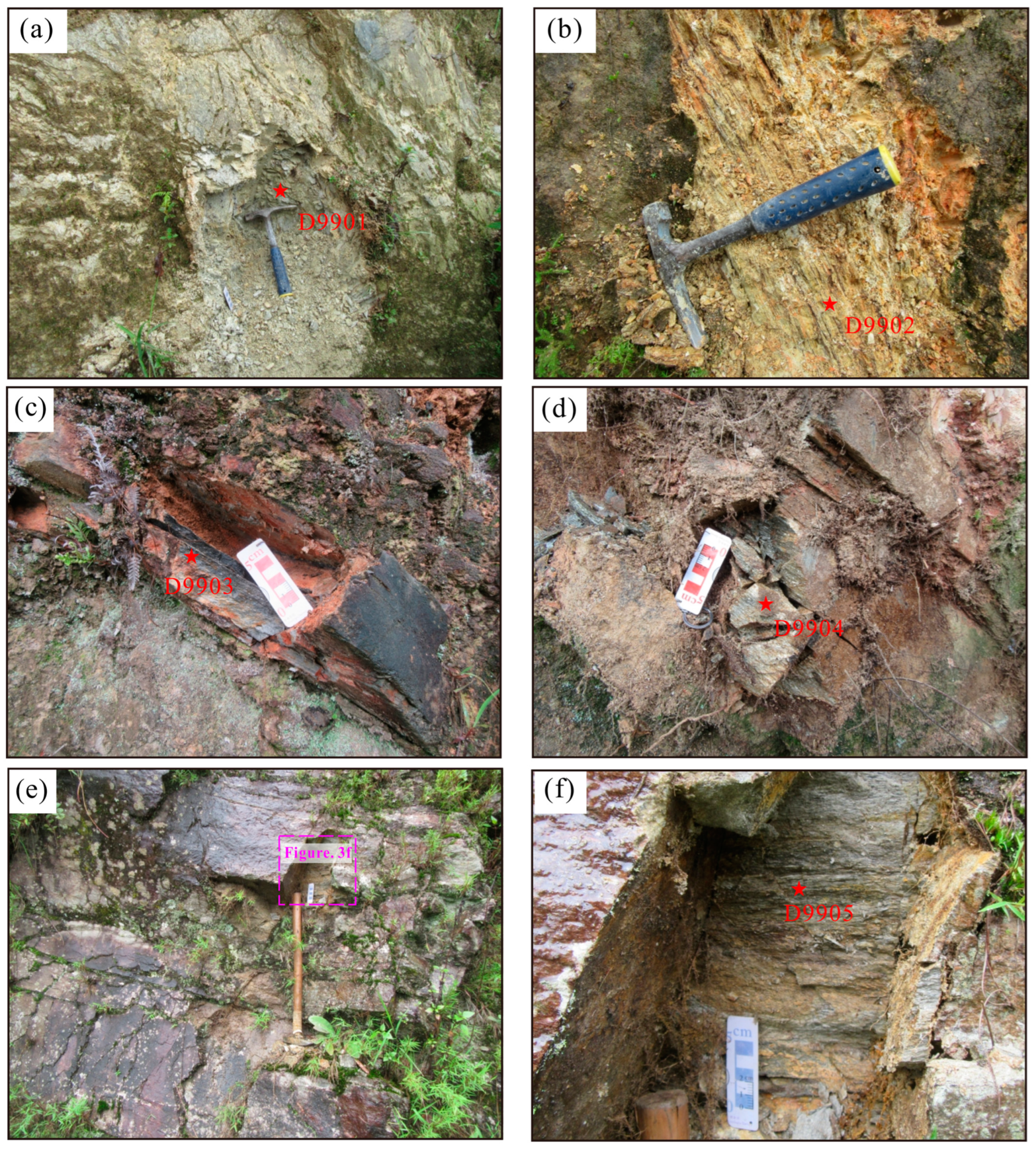
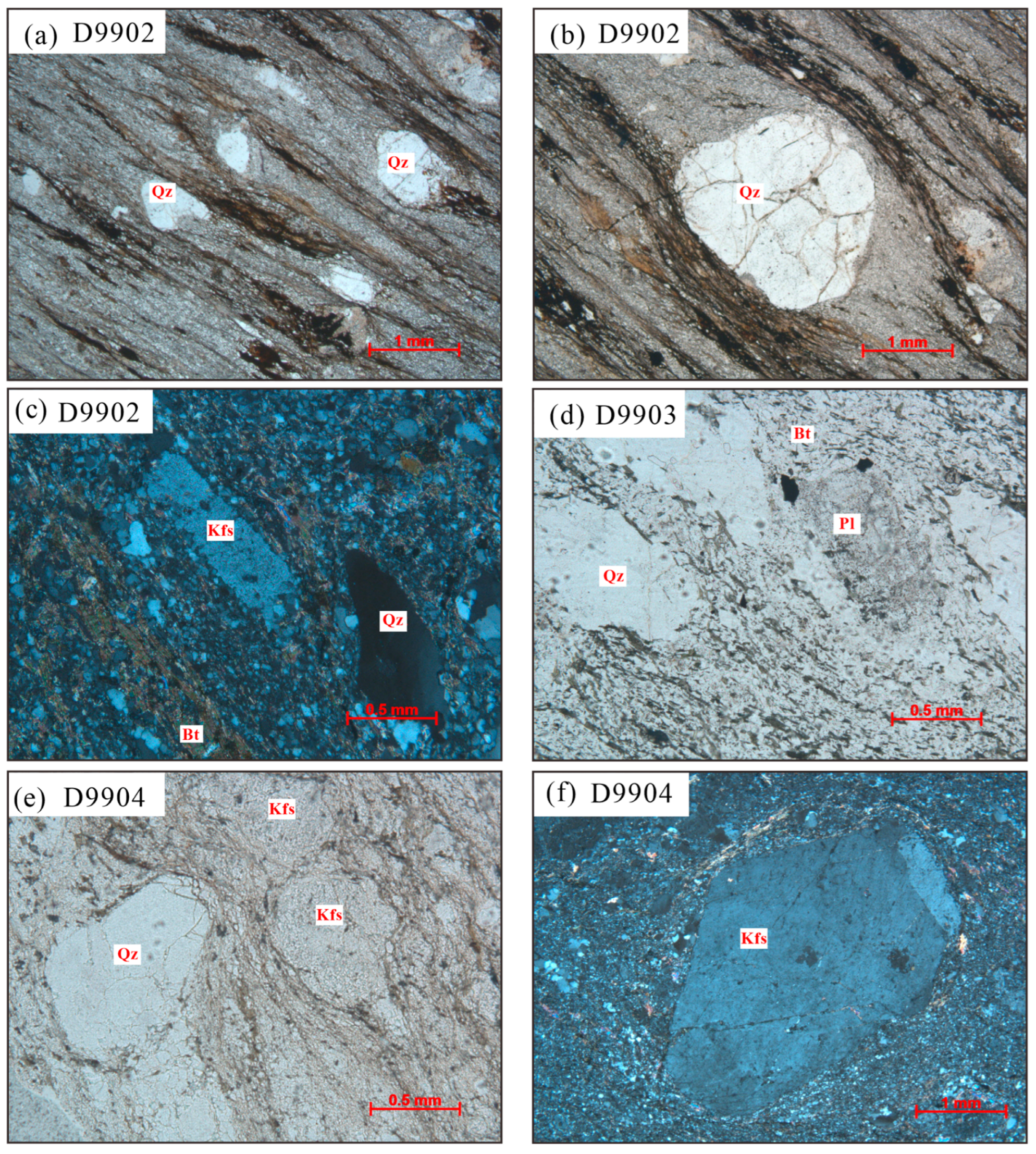
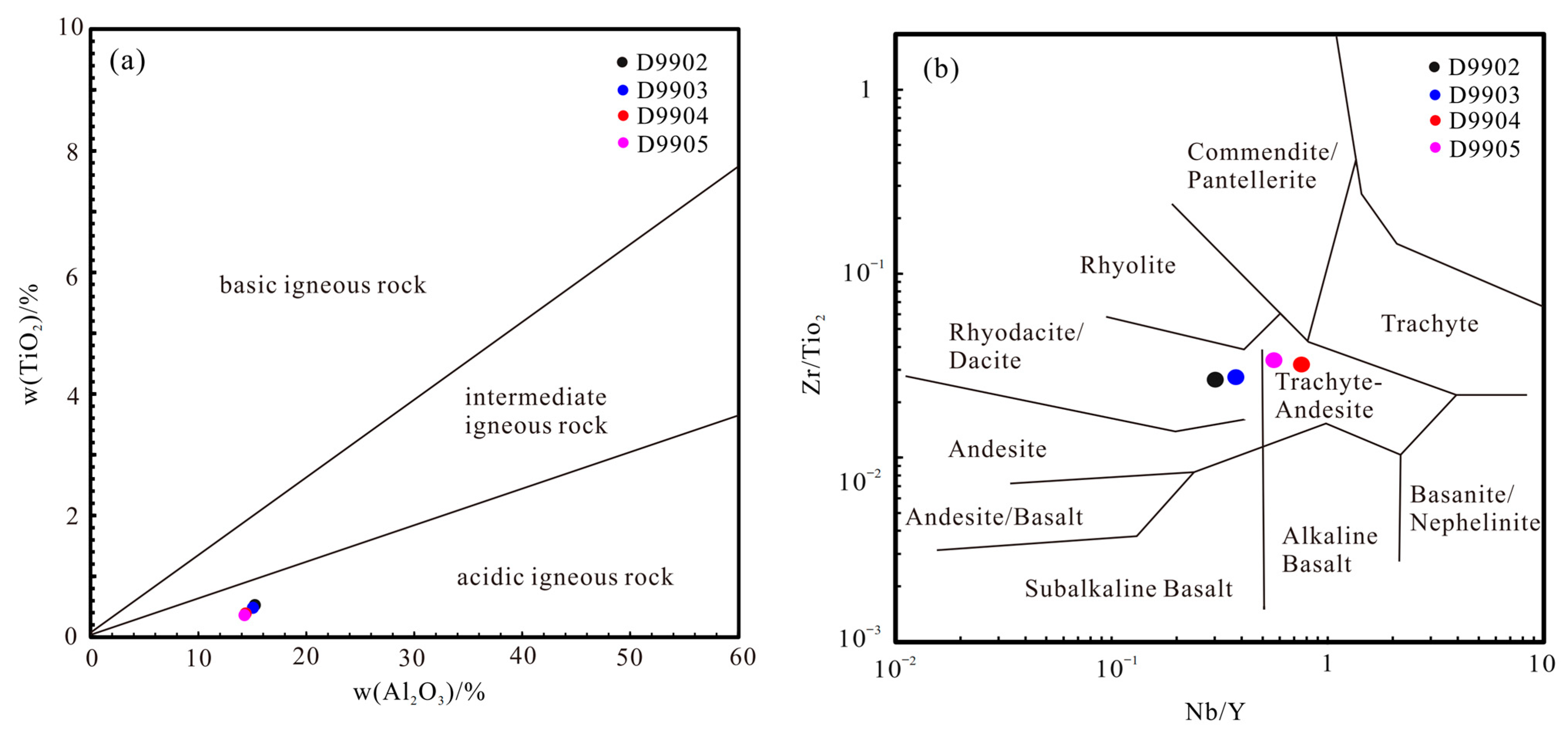
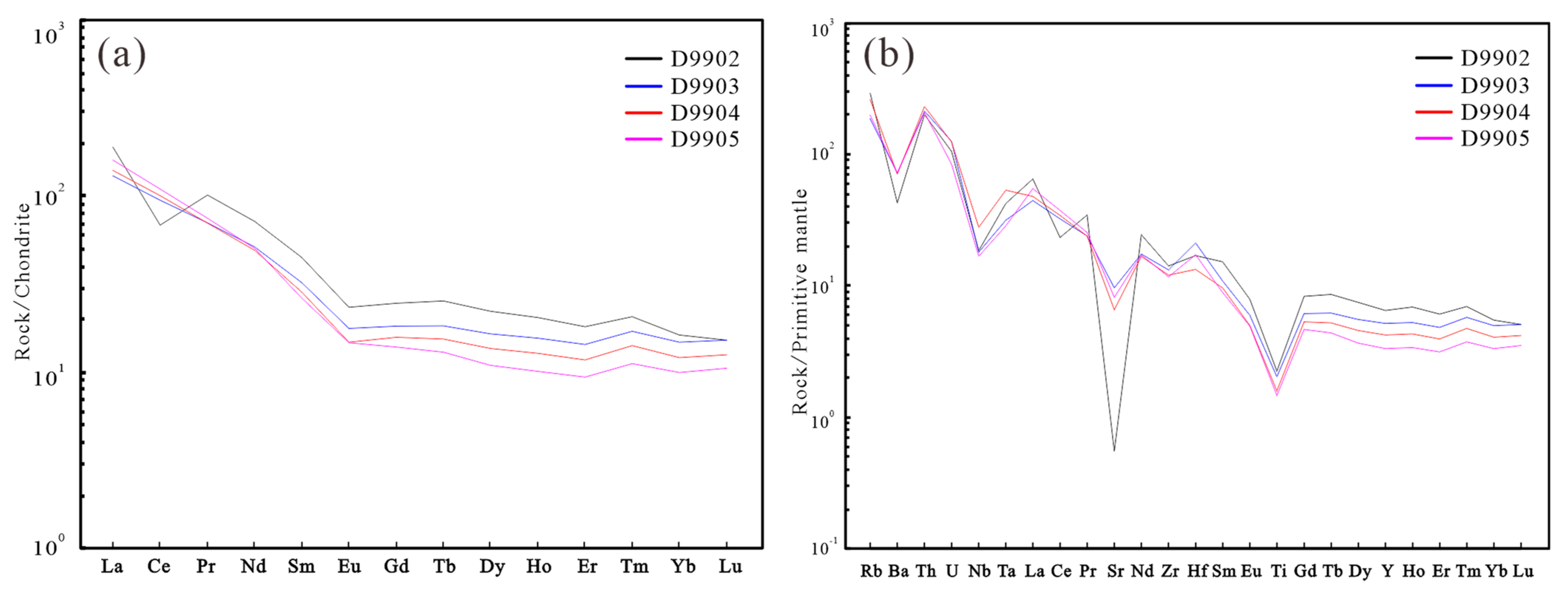
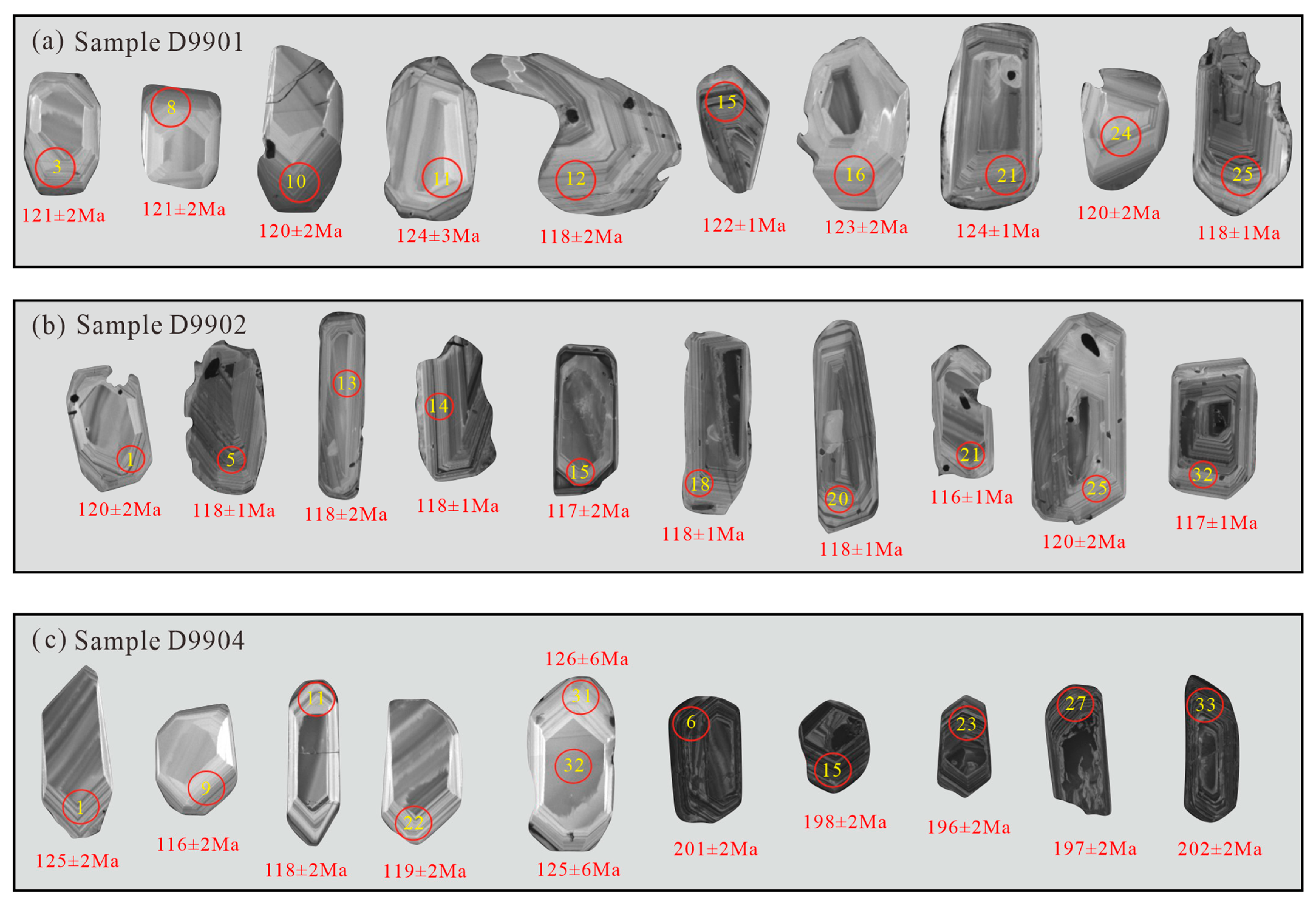
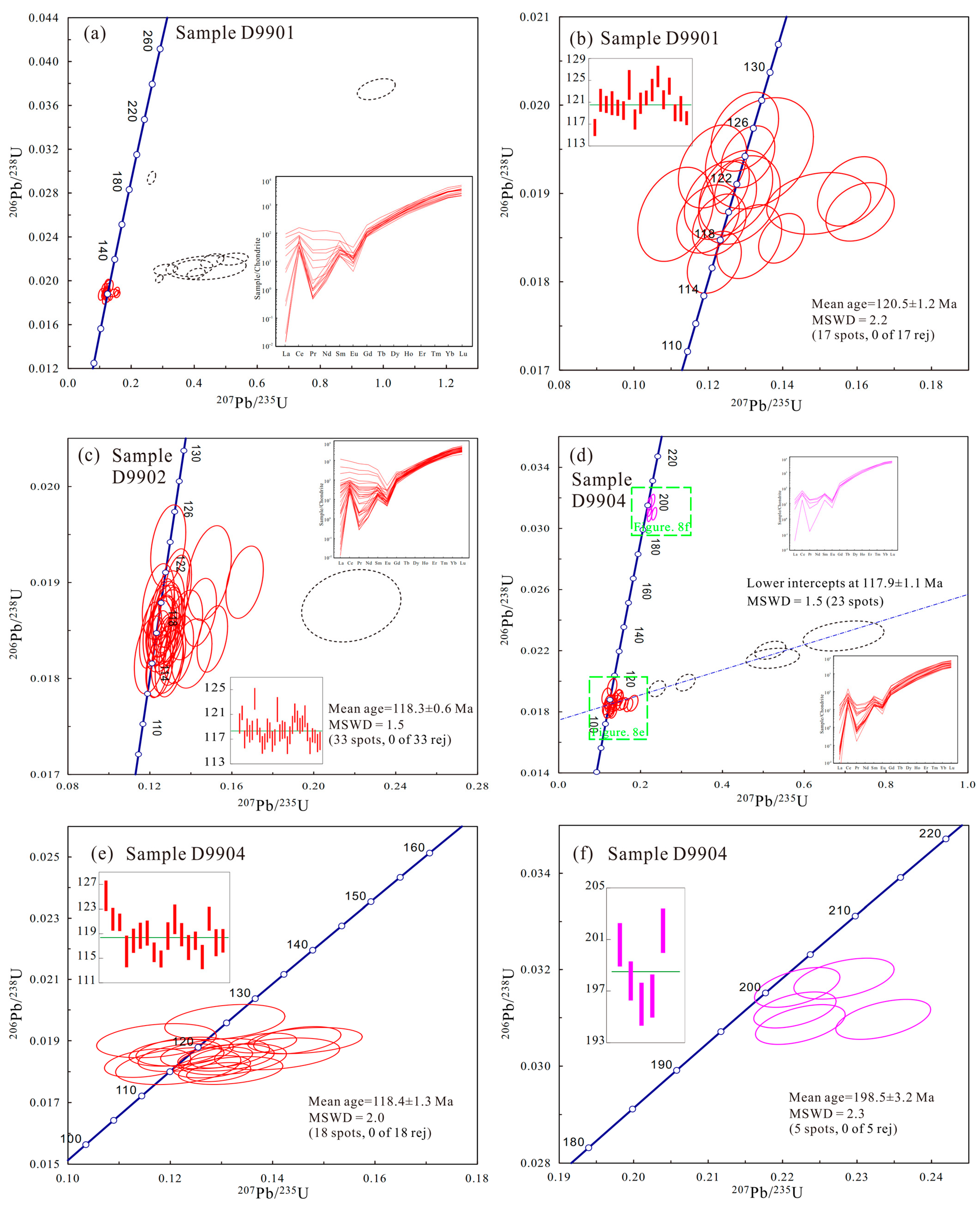
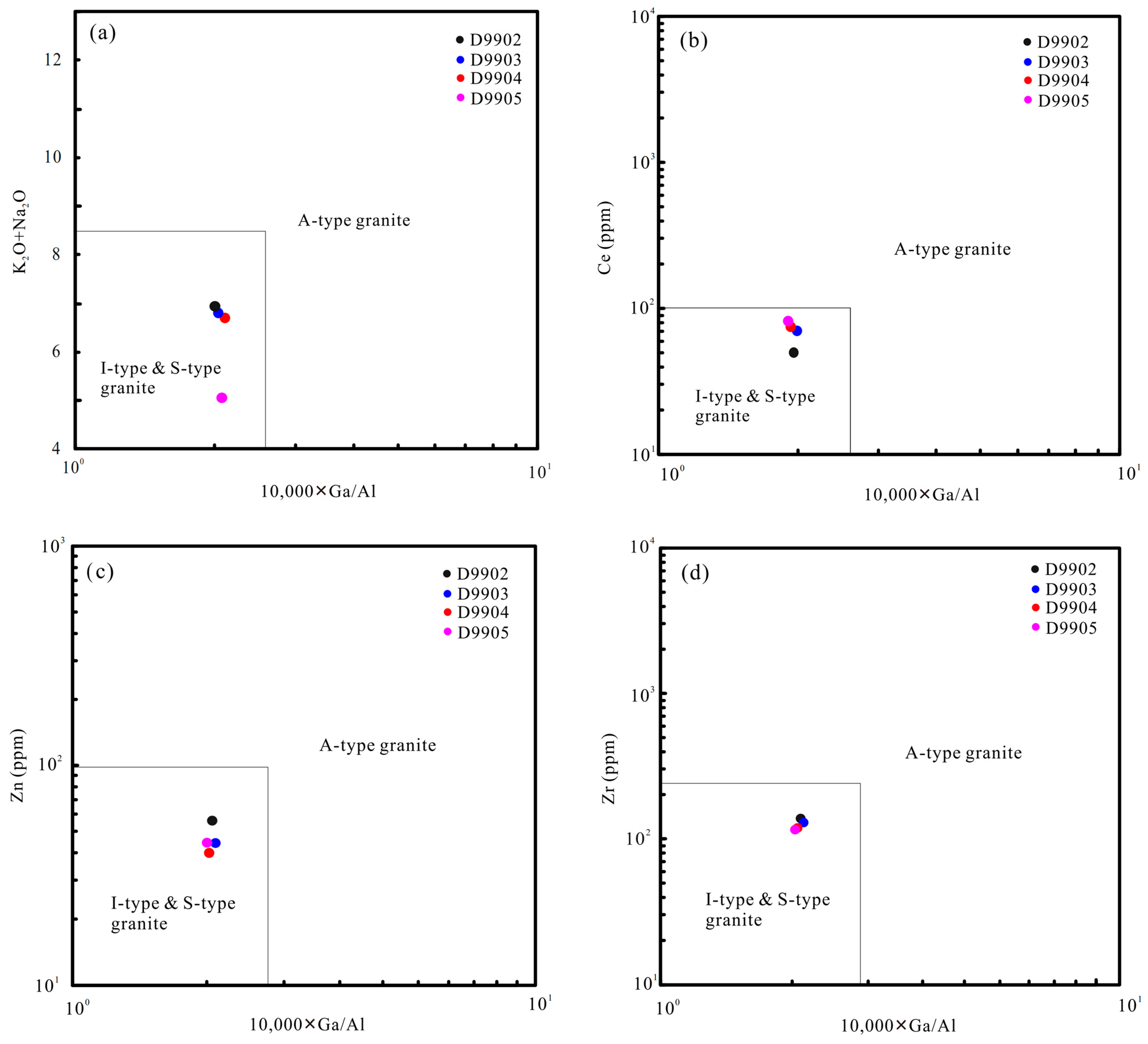

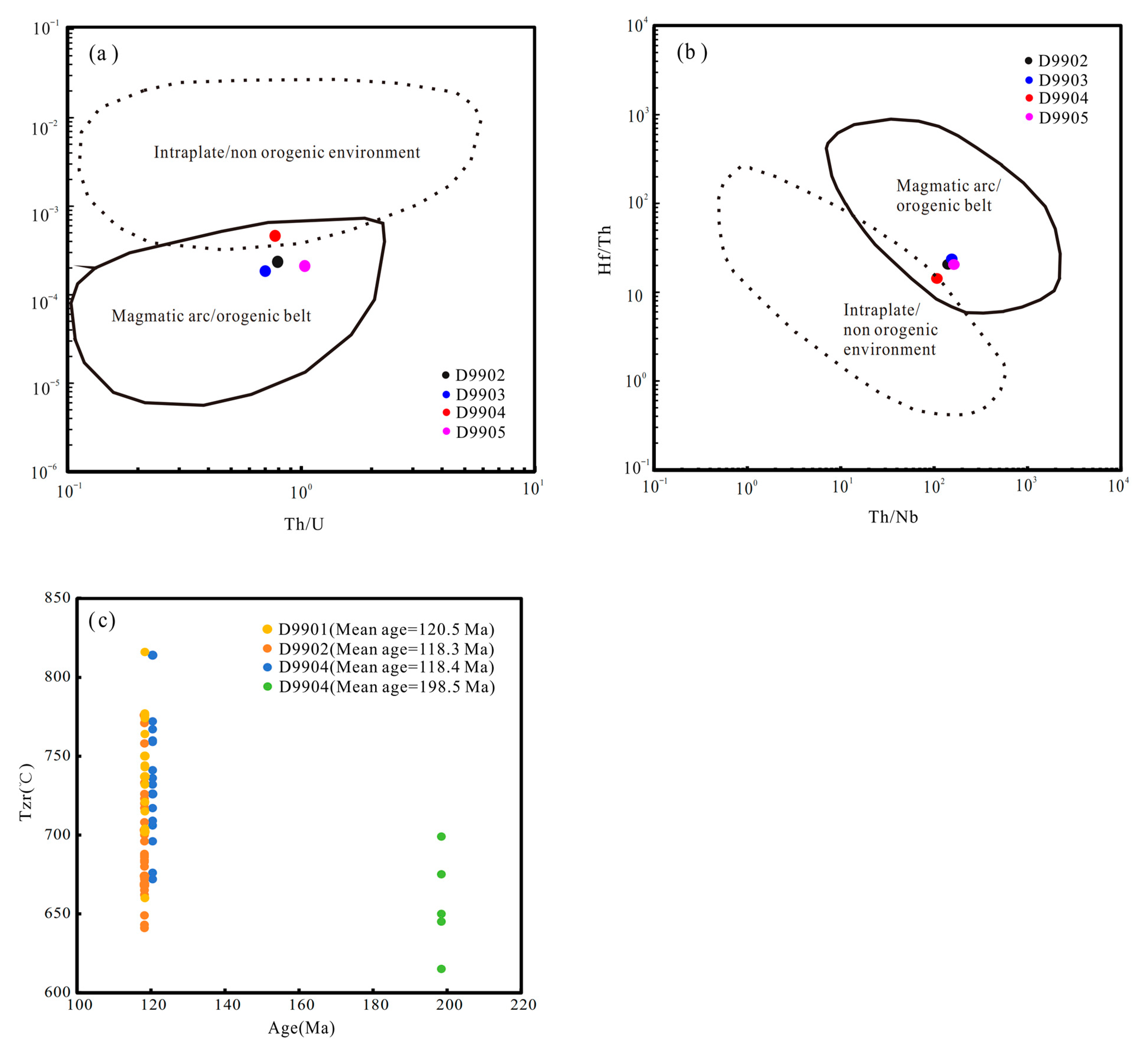
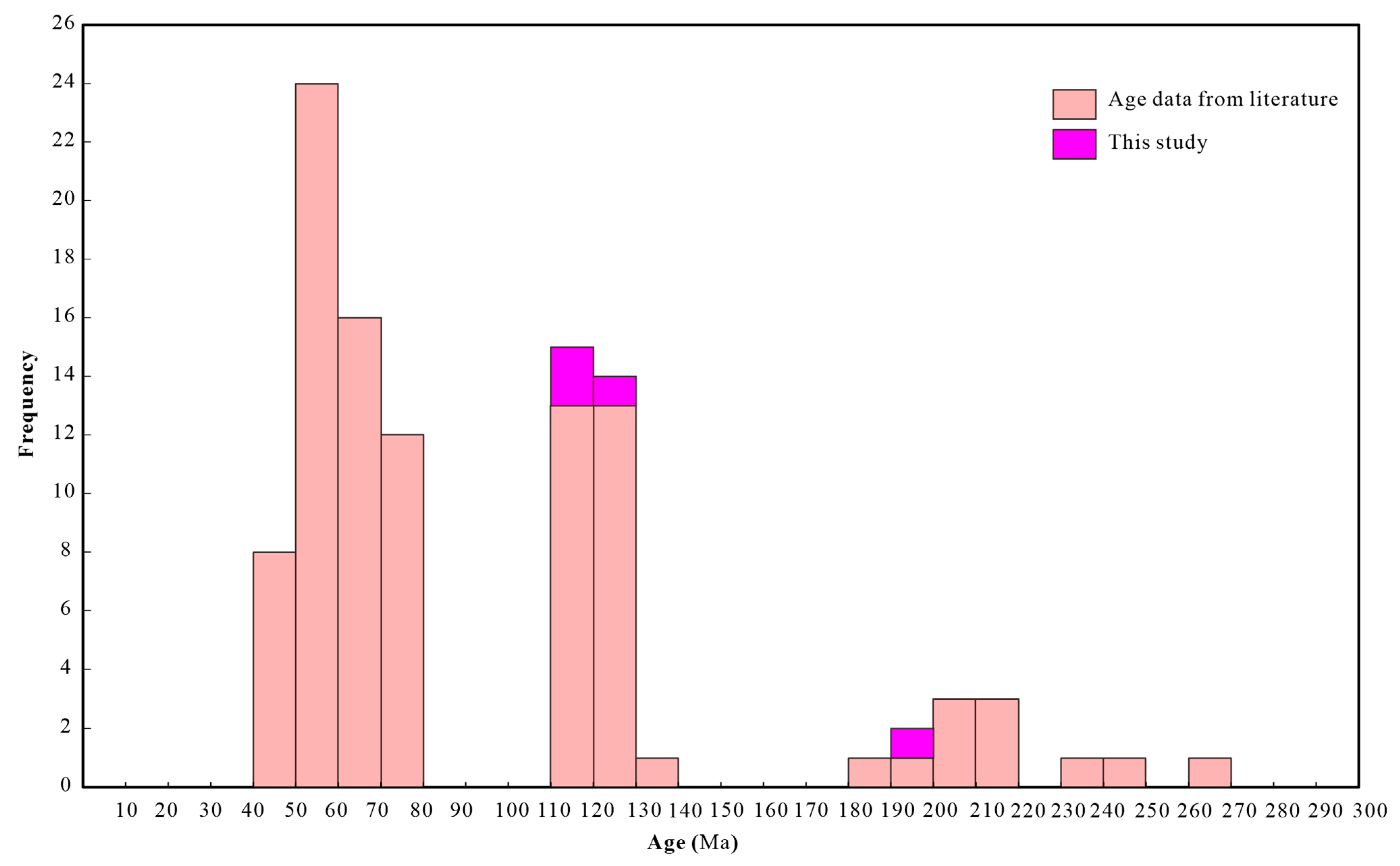
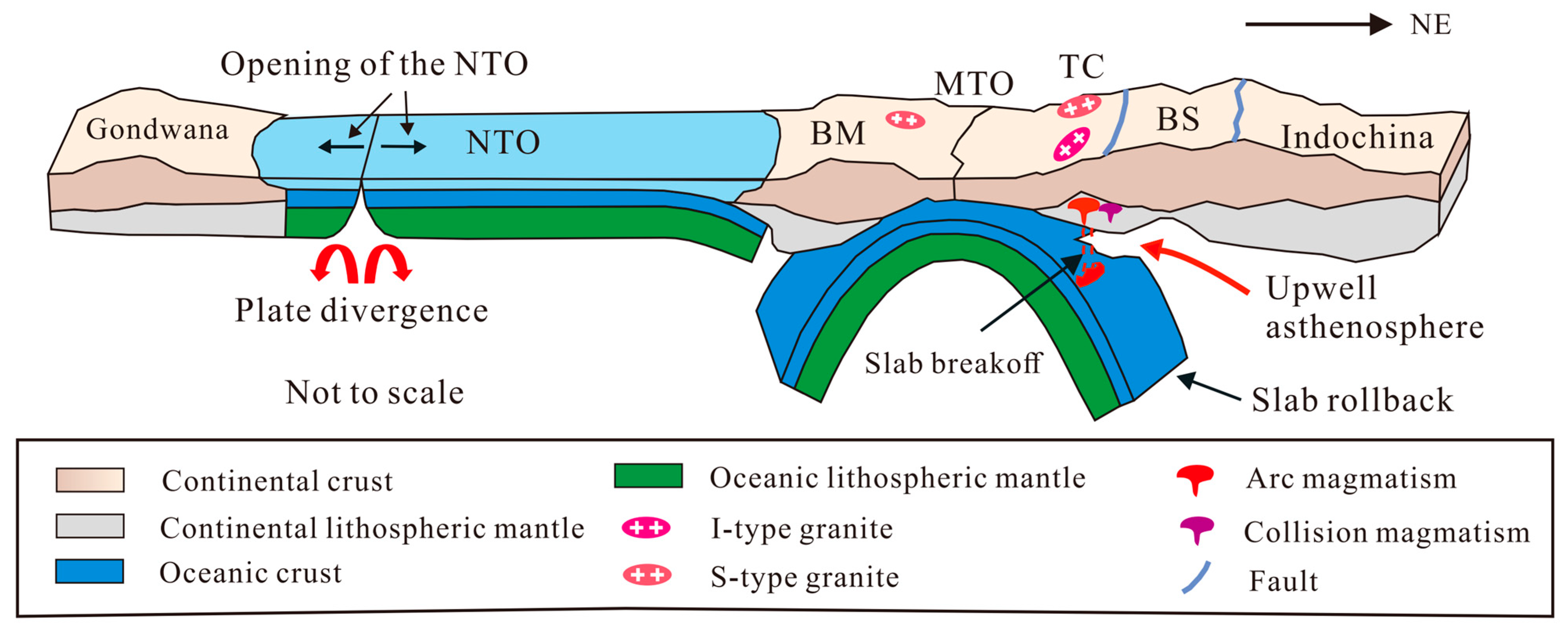
Disclaimer/Publisher’s Note: The statements, opinions and data contained in all publications are solely those of the individual author(s) and contributor(s) and not of MDPI and/or the editor(s). MDPI and/or the editor(s) disclaim responsibility for any injury to people or property resulting from any ideas, methods, instructions or products referred to in the content. |
© 2025 by the authors. Licensee MDPI, Basel, Switzerland. This article is an open access article distributed under the terms and conditions of the Creative Commons Attribution (CC BY) license (https://creativecommons.org/licenses/by/4.0/).
Share and Cite
Mo, X.; Gong, C.; Shang, Y.; Wu, J.; Wu, J.; Qi, R.; Wang, X.; Guan, Q.; Kong, X. Zircon LA-ICP-MS Dating and Geochemical Characteristics of Rhyolites from the Qushi Area, Tengchong Terrane, Yunnan Province. Minerals 2025, 15, 315. https://doi.org/10.3390/min15030315
Mo X, Gong C, Shang Y, Wu J, Wu J, Qi R, Wang X, Guan Q, Kong X. Zircon LA-ICP-MS Dating and Geochemical Characteristics of Rhyolites from the Qushi Area, Tengchong Terrane, Yunnan Province. Minerals. 2025; 15(3):315. https://doi.org/10.3390/min15030315
Chicago/Turabian StyleMo, Xiong, Chen Gong, Yan Shang, Jinglong Wu, Jialin Wu, Ronghui Qi, Xiaofeng Wang, Qi Guan, and Xu Kong. 2025. "Zircon LA-ICP-MS Dating and Geochemical Characteristics of Rhyolites from the Qushi Area, Tengchong Terrane, Yunnan Province" Minerals 15, no. 3: 315. https://doi.org/10.3390/min15030315
APA StyleMo, X., Gong, C., Shang, Y., Wu, J., Wu, J., Qi, R., Wang, X., Guan, Q., & Kong, X. (2025). Zircon LA-ICP-MS Dating and Geochemical Characteristics of Rhyolites from the Qushi Area, Tengchong Terrane, Yunnan Province. Minerals, 15(3), 315. https://doi.org/10.3390/min15030315






